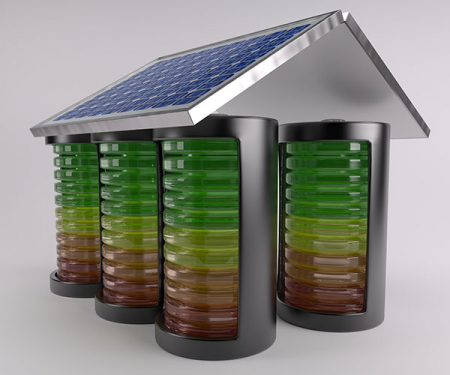Storage&Lighting
Solar Street Light System

In the course of designing solar led street lights,
just like many, you’d often encounter the problem of accurately sizing the battery. This is because,
when the battery is undersized, the street light won’t be able to sustain for up to 3 rainy or cloudy days.
Also, if the battery is oversized, you’d face the problem of sulfation, especially if it’s a flooded battery bank.
Well, we have decided to completely solve the challenge of accurately sizing your battery.
No need racking your head anymore on this task. By the time you’re done reading this, it’ll be such an easy task.
We’ve compiled a detailed breakdown and a step by step guide to sizing the battery for your solar led street light.
Best battery type for off-grid solar system: Deep cycle battery
For your information,
the Battery type used for off-grid solar streetlights are commonly deep cycle batteries.
What do I mean?
Not just any kind of battery can be suitable for off-grid solar street lights;

Solar battery, Deep cycle battery
Since off-grid solar streetlight is a stand-alone solar power system, all of its power supply is from batteries (not from electricity utilities), this requests that the batteries must be able to undergo repeated and deep discharges, deep cycle batteries partake of these requested characteristics.
Since off-grid solar streetlight is a stand-alone solar power system, all of its power supply is from batteries (not from electricity utilities), this requests that the batteries must be able to undergo repeated and deep discharges, deep cycle batteries partake of these requested characteristics
Besides,
it’s very important that you clearly understand some related terms of solar batteries. This will help you understand the battery sizing process.
Essential terms need to know:
1. Battery Capacity & Power
The Power rating is the amount of energy that can be supplied by a battery at one time, it is measured in Watts. Let’s assume that a 12V battery supply 2Amps current to the solar system, we can say the battery can supply 24Watts.
Power(W) = Voltage(V) x Current (Amps) = 12V x 2A = 24W
The battery capacity is the total amount of energy that can be stored by the battery, its unit is KWh, if the battery can supply 24W for 100 hours totally, we will say, its capacity is 2.4KWh.
Capacity(Wh) = Voltage(V) x Current (Amps) x Time(Hours) = 12V x 2A x 100h /1000 = 2.4KWh

LiFePO4 battery
2. Amp-hour
the Amp-hour is another expression of the battery capacity.
if the battery nominal voltage is 12V, and it can totally continue to release 2Amps current for 10hours,
we can see its capacity is 12 x 2 x 10 = 240Wh, or 20Ah.

Solar led lights
3. Depth of Discharge
Depth of Discharge(DoD) refers to the available amount of energy that can be used in a battery when it is processed from a fully charged state to a fully discharged state.
if the battery’s capacity is 100KWh, only 60KWh can be released to power the solar system, its DoD is 60%.
Therefore, the DOD is a very important factor in the calculation of sizing the battery for solar street lights.
as we known, a LiFePO4 battery type’s DOD is 80 percent, while GEL battery DOD is 50 percent.

30% Depth of Discharge
4. Battery Working Temperature
This refers to the ideal environmental temperature for a battery. The ideal temperature is 27°C (80°F) because a battery’s internal reaction is optimal at this temperature.
If the temperature is lower, the battery’s efficiency will be reduced.
higher temperature improves the efficiency only if it’s a little above 27°C and for a shorter time.

Battery does not work in cold weather
Solar battery calculation: step by step
Let’s go through an example to explain the battery sizing process step by step.
Step 1: Prepare the data that is required.
· Rated LED power,
· Rated working voltage of LED
· LED brigthness settings during night
· days of autonomy
· battery type and its DoD
Let’s assume
the rated power of the LED lamp in a solar streetlight is 30W at 12V.
LED brightness at night will be set as: 1 hour 60% + 5 hours 100% + 6 hours 40%
3 days of autonomy, in others ways, it can support 3 raining/cloudy days
battery type is LiFePO4 batteries, the DoD would be 80%
Step 2: Calculate daily energy consumption of LED lamp
the current consumption of the LED lamp = 30/12 = 2.5Amps
the total power consumption in a day = 8Hours at 100% brightness
so the daily power consumption = 2.5 x 8 = 20Ah.
Step 3: Considering the 3 days’ autonomy
if we design the solar-powered streetlights can sustain for 3 raining/cloudy days, then we should multiply daily power consumption by days of autonmy
that will be, 20Ah x 3 = 60Ah.
Step 4: Considering the depth of discharge.
in this example, our battery type is LiFePO4, and Its DoD is 80%
so the battery size should be 60Ah/80% = 75Ah
{pboot:if('Home Solar Energy System'<>'没有了!'Previous:Home Solar Energy System{/pboot:if}
Next:Solar Traffice Light
-
About Us
Company Profile Company Culture Company Honor Development Path -
Product
Car stop&ignition Battery Car Battery Energy storage battery Tool Battery -
News
Company News Industry Dynamics -
Case
Smart Device Vehicle Power Storage&Lighting Lithium ion Battery -
Service
Customer Service Technical Support Products Catalogue -
Contact Us
Contact Us Message


